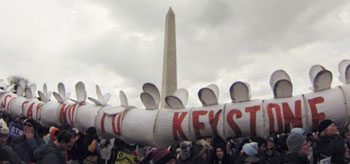Today, the Environmental Protection Agency (EPA) released its comments on the Keystone pipeline, clearly paving the way for its rejection if the State Department makes a recommendation based on science.
Federal agencies have the option of weighing in on Keystone as the final step in the State Department’s third environmental analysis (Supplemental Environmental Impact Statement – SEIS). So far, every contractor it hired to do the job has had ties to TransCanada or the tar sands industry.
This is the second time EPA has commented. The EPA could play a pivotal role if it decides to. The State Department can issue the cross-country permit on its own if no other agency objects, but if the EPA were to object, issuing the final permit is in President Obama’s hands alone.
The Department of Interior (DOI) also submitted concerns about the many protected areas – including national parks and scenic rivers – the pipeline would affect, through potential spills, construction noise and lights at night. DOI previously asked for a year’s worth of frequent inspections and notes they still don’t know if they will take place just once, weekly or monthly. The agency expressed apprehension about the pipeline’s impact on many species of wildlife, including migrating birds.
DOI says the project would result in "permanent impacts to wildlife" along the route, and finds the State Department’s conclusion that there would be no negative impacts on endangered species "unsupported."
Also important is that tribal concerns have not been adequately addressed in the permitting process, notes DOI. Tribes along the proposed route are strongly opposed to the pipeline, and DOI urges the State Department to recognize and respect their treaty rights to land and water that would be threatened should the pipeline be built.
EPA points to:
- continued concern about the route of the pipeline crossing over the Ogallala Aquifer and the potential for spills.
- emphasizes that TransCanada should be responsible for clean-up and restoration of groundwater and surface water
- the State Department analysis "makes it clear that oil sands crude has significantly higher lifecycle greenhouse gas emissions than other crudes. The Final SEIS states that lifecycle greenhouse gas emissions from development and use of oil sands crude is about 17% greater than emissions from average crude oil refined in the US on a wells-to-wheels basis."
-
life-cycle analysis of the 830,000 barrels a day that would travel through Keystone would result in increased emissions equal to almost 9 coal-fired power plants, releasing 1.37 more tons of greenhouse gases into the atmosphere over its 50 year lifetime.
Other analyses find building the pipeline’s impact equal to 51 coal-fired power plants.
"Until ongoing efforts to reduce greenhouse gas emissions associated with production of oil sands are more successful and widespread, the final SEIS makes clear that, compared to reference crudes, development of oil sands crude represents a significant increase in greenhouse gas emissions," says EPA.

Even acknowledging these facts in the SEIS, the State Department justified approving Keystone because, they reasoned, the oil would get to market with or without the pipeline. But that was when oil prices were high so shipping it by rail (which costs more) wouldn’t be a barrier. Now that prices have dropped substantially, this theory doesn’t hold. Even though low prices may be temporary, they are clearly volatile, EPA says.
Because of this, EPA concludes building Keystone would indeed promote greater tar sands production and thus, create even more greenhouse gas emissions.
Tom Goldtooth, Executive Director of the Indigenous Environmental Network comments, "The EPA’s comments merely affirm what we already knew. This dirty tar sands pipeline fails the President’s climate test. It will contribute significantly to the increase of greenhouse gas emissions. It will encourage tar sands development, which will further threaten the lives of the Cree & Dene people of northern Alberta. It’s time for the President to make the right decision and reject the permit for the Keystone XL pipeline."
Over the years, President Obama has received pleas to reject Keystone from Nobel laureates (three letters), progressive businesses, Obama’s own staff, big Democratic donors, President Jimmy Carter and Archbishop Desmond Tutu.
Can’t Comment on Energy East
Meanwhile, Canada pushes ahead on the Energy East pipeline, which would carry even more tar sands oil – 1.1 million barrels a day – from Alberta all the way to the Atlantic Ocean. An unprecedented 100,000 comments against the pipeline were delivered to the National Energy Board this week, but amazingly, the law has been changed on environmental review processes.
Only people the agency considers to be "directly affected" by the pipeline can comment and even then they must choose from a pre-determined list of issues – concerns about climate change are not on the list.
Here is EPA’s letter to the State Department:

Given the reasons the EPA has presented against approval of the Keystone XL Pipeline, President Obama should override, if necessary, the State Department’s decision if State’s final report disregards or minimizes the tar sands oil’s significant contribution to greenhouse gases.